Jarnsaxa is one of the lesser-known characters in Norse mythology, but her mystery is only one of the things that makes her the most interesting. When Carin game me the original writing prompt, I started researching the spot she described.
North of the 60th parallel in the Baltic is The Aland Islands. During the summer, they’re a popular destination for tourists seeking rustic peace. Mostly, they’re known for iron mining (abandoned in the 1800s), beets, and cows. In ruminating on the most concrete elements (wind, waves, iron) and doing some meditative web-surfing, I found Jarnsaxa. She’s a creature who comes up in important ways in Norse mythology, but much is left out. Jarnsaxa makes ripe material for contemporary imagination.
We know a little bit about her and what she does. Her name is a portmanteau of the Swedish words for iron, axe, and scissors (jarn, yxa, and saxa, respectively). In the Poetic Edda (considered one of the oldest texts of Norse culture), we learn that she is one of The Nine Mothers of Heimdall. These Wave-Maidens were responsible for turning the mill which runs the wind and the waves. After Heimdall leaves his mothers to seek his fortune, Jarnsaxa disappears from the Eddas for a while.
She reappears as Thor’s lover. Like before, as a Wave-Maiden, she is a giantess. We learn that she is a Jotun, the same race as Loki. She is also the mother of Thor’s sons, Magni and Modi (respectively named for physical strength, and the desire to fight and kill). It is prophesied that Modi and Magni will eventually inherit Mjölnir, Thor’s hammer, when it is thrown at the end of Ragnarok (the Old Norse apocalypse). We also know from other places in the Eddas that Thor’s official wife is Sif, the goddess of fertility.
So, what can we assume, based on this information? Jarnsaxa has been called Thor’s mistress, lover, even co-wife, but never does she have the role that monogamous marriage confers. Sif is a fertility goddess, associated with summer and the harvest, so she must cover Thor’s aspect as a thunder god and bringer of rain. Therefore Jarnsaxa must cover his warrior aspect. Jarnsaxa’s children embody a warrior’s best qualities, and it’s safe to assume they didn’t only get this from their old man. Shield maidens were an acceptable role in Old Norse culture, a way that women could fight alongside their community, without the official title of Viking. Jarnsaxa’s fighting qualities can be supposed not only from her name, but also her surroundings. Since the Aesir generally looked down on Jotuns, as uncouth and wild, but she snagged Thor, she definitely had to be smoking hot and a lot of fun to be with.
Loki and Thor share many adventures, generally stories in which Loki and/or his Jotun comrades are harmed. Since Loki and Jarnsaxa are both Jotuns, it’s safe to assume they share a bond. Loki will eventually helm the ship that sails against the Aesir in Ragnarok, and Jarnsaxa’s children will directly benefit from Thor’s defeat. Since she’s bearing Thor’s children without The Aesir’s blessing or status, and will benefit from the destruction of the Aesir, all that can come in the middle is a desire for revenge.
Returning to the original proposition, we can take a look at a sentient wind farm, and wonder how it got that way, and what it wants. The world of Old Norse culture lends itself to liminality, a flexibility of boundaries between the past and present, natural and supernatural worlds. This is a place with Northern Lights and white nights, and the states of dreaming and being awake can become blurred. How does Jarnsaxa fit into this scheme?
The Draugr is the Old Norse version of the walking dead. This is just one version of the ways in which souls can transcend the mortal experience. Sometimes, if a dead person is not properly buried, or has unfinished business, their body can live on after them, or, simply, their will. It can inhabit animals, attacking the living until it gets what it wants. In the Eyrbyggja Saga, the will of a dead woman inhabited a seal, attacking humans until its bedclothes were burned, as the departed woman had requested. This story is a precursor of the Irish and Scots folk creature, the Selkie.
More common are the souls of corpses washed up on shore. Having committed no crime, but without a proper funeral, their soul would wander until their body was properly buried. If a living person were to pass the body without trying to help its soul, the ghost would follow and hunt them until it received satisfaction. Stories of supernatural women taking over untended farms at The Winter Solstice, Christmas, and New Year’s Eve (the darkest time of the year in the Northern hemisphere), are popular in Old Norse culture. In some cases, the woman is disguised as a quiet farm girl, who refuses to go to Mass, but instead turns into an Elf Queen and throws a secret party for all of her elvish friends. In other cases, the quiet farm girl reveals a murderous nature, slaughtering livestock and whoever might try to stop her. Christian ritual is often not enough to stop restlessness. In the Eyrbyggja Saga, Thorgunna receives a Christian burial, but returns to tell everyone how cold her resting place is, until they finally fulfill her request to burn her bedclothes. As scholar Kirsti Kanerva says, the ghost is there to shine a light on past wrong, and get things in order, not because of the presence or absence of any particular religion. “The ghosts and wonders manifest the mental and social disequilibrium inherent in these situations…indicating in a concrete way the shadows of the past, deeds that have caused the balance of the minds of men and the order of their society to be shaken by the dead through fear, lunacy, illness, and death.” Like the ghosts in Macbeth and Hamlet, the undead in Old Norse culture are there to push the living to truth and justice.
So, how does a re-animated Jarnsaxa, fueled by revenge, fit into contemporary imagination?
She wants revenge on the Aesir. Like a corporation, this network of gods controls everything, from the seasons and weather to choices about food, shelter and sex. They set rules, and demand loyalty and homage. They can punish or reward, according to their whims. They can use and destroy the natural world however they please, and re-create it in their own image. An ancient giantess, turning a mill which feeds the wind and ways has its mirror opposite in a graceful silvery wind turbine, towering over land and sea to harness the wind’s energy. What comes around, goes around, literally.
Jarnsaxa gives us a means to explore themes of betrayal, sustainability, and revenge through an ancient metaphor. Norse mythology allows us the opportunity to explore time and space in a way which lends itself well to audio drama.
If you’re ready for Jarnsaxa’s saga, you can listen now. She’s available almost anywhere you find podcasts.
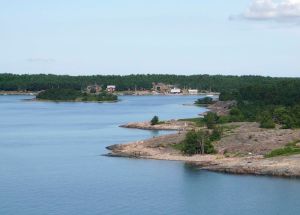
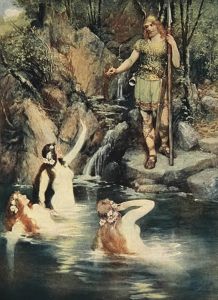
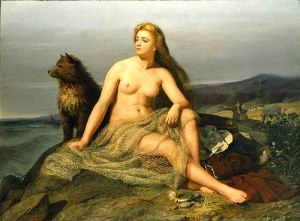
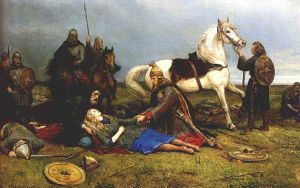
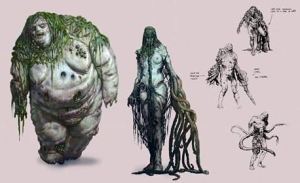

6 thoughts on “Who Is Jarnsaxa?”